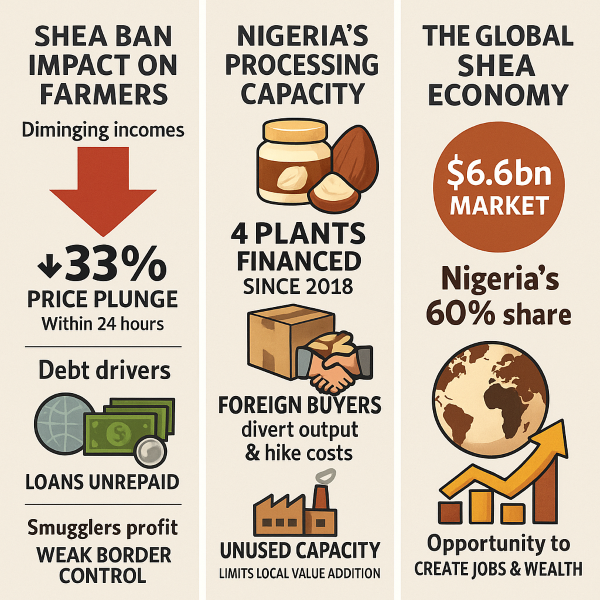Shea Export Ban: Industrialisation Push Policy or Big Blow to Nigerian Farmers?

Nigeria’s six-month suspension of raw shea nut exports has sparked a heated debate across the agricultural and trade ecosystem. While government officials frame the move as a strategic step to deepen value addition and spur industrialisation, farmers, traders, and analysts warn of unintended consequences—ranging from plummeting farmgate prices to smuggling risks and loss of investor confidence.
Farmers Count Their Losses
Within 24 hours of the ban’s announcement, the price of shea nuts collapsed from about ₦1 million per tonne to ₦700,000—a 33% drop that sent shockwaves through farming communities.
Dr. Joseph Ajanaku, President of the National Cashew Association of Nigeria, described the policy as “hurried and ill-conceived,” warning that it risks discouraging production altogether.
“By cutting off farmers’ main market overnight, we are killing agriculture,” he said. “Most smallholders already rely on loans; this disruption could push them into debt traps.”
Critics argue that six months is far too short a window to build the processing plants and technical capacity required to absorb raw supply locally. Importing and installing equipment alone takes a minimum of two months, while training and certification require even longer.
Trade Analysts See Risks of Smuggling and Spillovers
Nigeria’s shea sector, which accounts for up to 60% of global production and sustains thousands of rural women, has long been targeted by foreign buyers who transport raw nuts to neighbouring countries for processing. Observers warn that the ban, without adequate safeguards, could drive more smuggling into Togo and Benin rather than foster local beneficiation.
The Alliance for Economic Research and Ethics (AERE) urged government to adopt a phased approach, pointing to examples from Ghana and Indonesia where managed timelines and consultation preserved market stability.
“Policy reversals without transition strategies undermine confidence,” said AERE’s Chairman, Dele Oye. “Nigeria risks jeopardising existing trade contracts unless it backs the ban with financing, clear communication, and technical support.”
Supporters Say Ban Will Secure Local Processors
On the other hand, Abba Bello, Managing Director of NEXIM Bank, welcomed the policy as a lifeline for Nigeria’s nascent processing industry.
“Until 2018, not one industrial plant processed shea in Nigeria. Today, four plants are operational, but they struggle to secure raw material against deep-pocketed foreign buyers,” he explained.
“The ban guarantees supply, lowers input costs, and stabilises their operations. In fact, I believe the suspension should be extended to one year to allow investments to mature.”
Bello called for broader policy reforms to phase out raw exports across other commodities, including cashew and cocoa, insisting that only value addition at home will create jobs and wealth.
Beyond Shea: Nigeria’s Industrialisation Test Case
The stakes go beyond shea nuts. Analysts warn that inconsistent agricultural policies—such as abrupt bans—risk spilling over into other value chains like cocoa, sesame, and cashew. If farmers abandon production due to uncertainty, processors will eventually face raw material shortages.
Experts propose a middle ground:
- Government intervention fund to buy up unsold stock during the transition.
- Stable power supply and infrastructure upgrades to support local processing.
- Capacity building and modern equipment to raise quality to global standards.
- Market intelligence and anti-smuggling task forces to protect trade flows.
BRANDECONOMY Insight
Nigeria’s shea sector is a $6.6 billion global industry waiting to be unlocked. But whether the current export ban becomes a stepping stone to industrialisation—or a stumbling block for farmers—depends on execution. For policymakers, the question is no longer whether to push for local value addition, but how to balance short-term livelihoods with long-term competitiveness.











